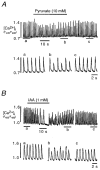Functional coupling between glycolysis and excitation-contraction coupling underlies alternans in cat heart cells
- PMID: 10790159
- PMCID: PMC2269904
- DOI: 10.1111/j.1469-7793.2000.00795.x
Functional coupling between glycolysis and excitation-contraction coupling underlies alternans in cat heart cells
Abstract
Electromechanical alternans was characterized in single cat atrial and ventricular myocytes by simultaneous measurements of action potentials, membrane current, cell shortening and changes in intracellular Ca2+ concentration ([Ca2+]i). Using laser scanning confocal fluorescence microscopy, alternans of electrically evoked [Ca2+]i transients revealed marked differences between atrial and ventricular myocytes. In ventricular myocytes, electrically evoked [Ca2+]i transients during alternans were spatially homogeneous. In atrial cells Ca2+ release started at subsarcolemmal peripheral regions and subsequently spread toward the centre of the myocyte. In contrast to ventricular myocytes, in atrial cells propagation of Ca2+ release from the sarcoplasmic reticulum (SR) during the small-amplitude [Ca2+]i transient was incomplete, leading to failures of excitation-contraction (EC) coupling in central regions of the cell. The mechanism underlying alternans was explored by evaluating the trigger signal for SR Ca2+ release (voltage-gated L-type Ca2+ current, ICa,L) and SR Ca2+ load during alternans. Voltage-clamp experiments revealed that peak ICa,L was not affected during alternans when measured simultaneously with changes of cell shortening. The SR Ca2+ content, evaluated by application of caffeine pulses, was identical following the small-amplitude and the large-amplitude [Ca2+]i transient. These results suggest that the primary mechanism responsible for cardiac alternans does not reside in the trigger signal for Ca2+ release and SR Ca2+ load. beta-Adrenergic stimulation with isoproterenol (isoprenaline) reversed electromechanical alternans, suggesting that under conditions of positive cardiac inotropy and enhanced efficiency of EC coupling alternans is less likely to occur. The occurrence of electromechanical alternans could be elicited by impairment of glycolysis. Inhibition of glycolytic flux by application of pyruvate, iodoacetate or beta-hydroxybutyrate induced electromechanical and [Ca2+]i transient alternans in both atrial and ventricular myocytes. The data support the conclusion that in cardiac myocytes alternans is the result of periodic alterations in the gain of EC coupling, i. e. the efficacy of a given trigger signal to release Ca2+ from the SR. It is suggested that the efficiency of EC coupling is locally controlled in the microenvironment of the SR Ca2+ release sites by mechanisms utilizing ATP, produced by glycolytic enzymes closely associated with the release channel.
Figures







References
-
- al-Habori M. Microcompartmentation, metabolic channeling and carbohydrate metabolism. International Journal of Biochemistry and Cell Biology. 1995;27:123–132. - PubMed
-
- Badeer HS, Ryo UY, Gassner WF, Kass EJ, Cavaluzzi J, Gilbert JL, Brooks CM. Factors affecting pulsus alternans in the rapidly driven heart and papillary muscle. American Journal of Physiology. 1967;213:1095–1101. - PubMed
-
- Berlin JR. Spatiotemporal changes of Ca2+ during electrically evoked contractions in atrial and ventricular cells. American Journal of Physiology. 1995;269:H1165–1170. - PubMed
-
- Bers DM. Excitation-Contraction Coupling and Cardiac Contractile Force. Boston MA, USA: Kluwer Academic Publishers; 1991.
Publication types
MeSH terms
Substances
Grants and funding
LinkOut - more resources
Full Text Sources
Research Materials
Miscellaneous

